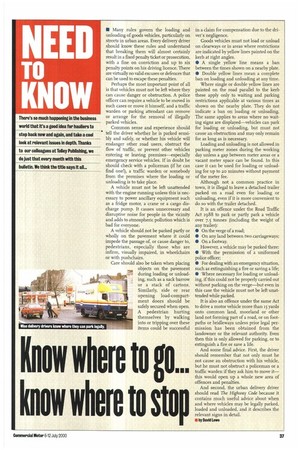know where to go... know where to stop
Page 39

If you've noticed an error in this article please click here to report it so we can fix it.
• Many rules govern the loading and unloading of goods vehicles, particularly on streets in urban areas. Every delivery driver should know these rules and understand that breaking them will almost certainly result in a fixed penalty ticket or prosecution, with a fine on conviction and up to six penalty points on his driving licence. There are virtually no valid excuses or defences that can be used to escape these penalties.
Perhaps the most important point of all is that vehicles must not be left where they can cause danger or obstruction. A police officer can require a vehicle to be moved in such cases or move it himself, and a traffic warden or parking attendant can remove or arrange for the removal of illegally parked vehicles.
Common sense and experience should tell the driver whether he is parked sensibly and safely, or whether his vehicle will endanger other road users, obstruct the flow of traffic, or prevent other vehicles entering or leaving premises—especially emergency service vehicles. if in doubt he should check with a policeman (if he can find one!), a traffic warden or somebody from the premises where the loading or unloading is to take place.
A vehicle must not be left unattended with the engine running unless this is necessary to power ancillary equipment such as a fridge motor, a crane or a cargo discharge pump. It causes unnecessary and disruptive noise for people in the vicinity and adds to atmospheric pollution which is bad for everyone.
A vehicle should not be parked partly or wholly on the pavement where it could impede the passage of, or cause danger to, pedestrians, especially those who are infirm, visually impaired, in wheelchairs or with pushchairs.
Care should also be taken when placing objects on the pavement during loading or unloading, such as a sack barrow or a stack of cartons, Similarly, side or rear opening load-compart ment doors should be safely secured when open. A pedestrian hurting themselves by walking into or tripping over these items could be successful in a claim for compensation due to the driver's negligence.
Goods vehicles must not load or unload on clearways or in areas where restrictions are indicated by yellow lines painted on the kerb at right angles.
• A single yellow line means a ban between the times shown on a nearby plate.
• Double yellow lines mean a complete ban on loading and unloading at any time.
Where single or double yellow lines are painted on the road parallel to the kerb these apply only to waiting and parking restrictions applicable at various times as shown on the nearby plate. They do not indicate a ban on loading or unloading. The same applies to areas where no waiting signs are displayed—vehicles can park for loading or unloading, but must not cause an obstruction and may only remain for as long as is necessary.
Loading and unloading is not allowed in parking meter zones during the working day unless a gap between meter areas or a vacant meter space can be found. In this case it can be used for loading or unloading for up to 20 minutes without payment of the meter fee.
Although not a common practice in town, it is illegal to leave a detached trailer parked on a road even for loading or unloading, even if it is more convenient to do so with the trailer detached.
It is an offence under the Road Traffic Act 1988 to park or partly park a vehicle over 7.5 tonnes (including the weight of any trailer): • On the verge of a road; • On any land between two carriageways; • On a footway.
However, a vehicle may be parked there: • With the permission of a uniformed police officer; • For dealing with an emergency situation, such as extinguishing a fire or saving a life; • Where necessary for loading or unloading, if this could not be properly carried out without parking on the verge—but even in this case the vehicle must not be left unattended while parked.
It is also an offence under the same Act to drive a motor vehicle more than 15 yards onto common land, moorland or other land not forming part of a road, or on footpaths or bridkways unless prior legal permission has been obtained from the landowner or the relevant authority. Even then this is only allowed for parking, or to extinguish a fire or save a life.
And some final advice. First, the driver should remember that not only must he not cause an obstruction with his vehicle, but he must not obstruct a policeman or a traffic warden if they ask him to move it— this would open up a whole new area of offences and penalties.
And second, the urban delivery driver should read The Highway Code because it contains much useful advice about when and where vehicles may be legally parked, loaded and unloaded, and it describes the relevant signs in detail.
• by David lows




















































































































